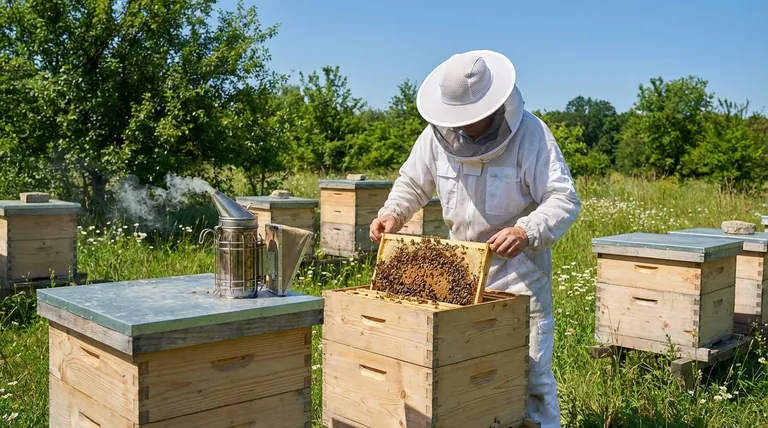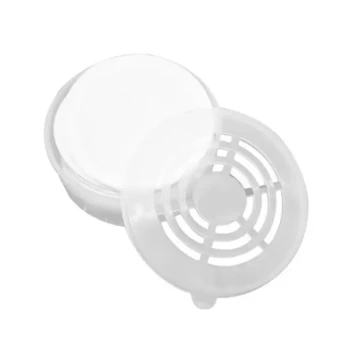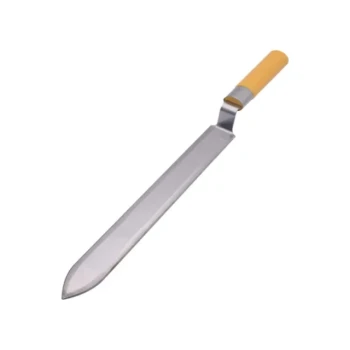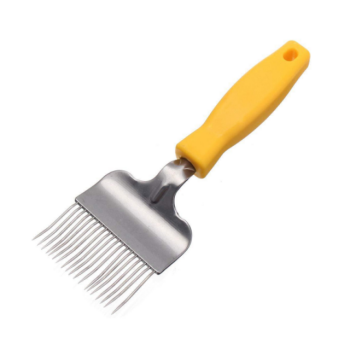In short, you should always wear a beekeeping suit if you are a beginner. For experienced beekeepers, the decision depends on the task's invasiveness and the temperament of the specific hive. However, for any task that involves opening the hive, a full suit is the safest and most professional choice.
The question isn't just about preventing stings; it's about managing risk so you can remain calm and confident while working. Your protective gear is a critical tool that allows you to focus on the health of the hive, not the fear of being stung.

Why a Suit is More Than Just Armor
A beekeeping suit's primary function is obvious, but its secondary benefits are what make it an indispensable tool for good hive management.
Protection from All Threats
A full suit provides a reliable barrier between you and the bees. This protection extends beyond honey bees to other aggressive pollinators you might encounter, such as yellow jackets.
It also offers practical benefits like sun protection during long hours spent working in your apiary.
The Confidence to Work Calmly
For new beekeepers, the fear of being stung can lead to jerky, nervous movements, which can agitate the bees. Wearing a full suit removes this fear, enabling you to work with smooth, deliberate motions that keep the colony calm.
This increased confidence is crucial for performing thorough, effective hive inspections.
Key Factors in Your Decision
While the default answer for beginners is "always wear a suit," experienced keepers weigh several factors before approaching a hive.
Your Experience Level
This is the most critical factor. A beginner has not yet learned to read a colony's mood or move in a way that minimizes disruption. Full protective gear should be considered mandatory until you have significant experience.
The Temperament of the Hive
Every bee colony has a unique personality. Some are incredibly docile, while others are highly defensive. You will learn the temperament of your specific bees over time.
The Nature of the Task
There is a major difference between a quick external observation and a full hive inspection. A simple check of the entrance requires less gear than a procedure like a honey harvest, which is highly disruptive to the colony.
Understanding the Trade-offs
Choosing your level of protection involves balancing safety against comfort and dexterity.
The Argument for Full Protection
Safety is paramount. A full suit virtually eliminates the risk of stings, allowing you to focus entirely on the task at hand. It is the professional standard for any invasive hive work.
The Argument for Minimal Gear
Some seasoned beekeepers argue that less gear makes them more sensitive to the hive's mood. They claim they can feel the "vibe" of the bees better and work more carefully as a result. This approach, however, carries obvious risks and is not recommended for most situations.
The Comfort Factor
Modern beekeeping suits are designed with both safety and comfort in mind. Materials like cotton are breathable, while polycotton blends offer a balance of protection and durability. In hot climates, ventilated suits are an ideal choice to prevent overheating.
A suit that fits properly—not too tight or too loose—is essential. Adjustable features ensure it is comfortable, which means you are more likely to wear it consistently.
Making the Right Choice for Your Goal
Your decision should always prioritize safety and the ability to work effectively.
- If you are a beginner beekeeper: Always wear a full protective suit to build confidence and ensure safety as you learn to handle bees.
- If you are performing a quick, non-invasive task: An experienced beekeeper may choose just a veil and gloves, but only with a familiar, docile colony.
- If you are conducting a full hive inspection or honey harvest: A full suit is the professional standard for these invasive procedures, regardless of your experience level.
- If you are working with an unfamiliar or known defensive colony: Full protective gear is non-negotiable to manage the significantly increased risk of stings.
Ultimately, your protective gear is the tool that empowers you to be a calm, confident, and effective caretaker of your bees.
Summary Table:
| Situation | Recommended Protection |
|---|---|
| Beginner Beekeeper | Full Suit (Mandatory) |
| Full Hive Inspection/Harvest | Full Suit (Professional Standard) |
| Quick, Non-Invasive Task (Experienced) | Veil & Gloves (with docile hive) |
| Unfamiliar/Defensive Hive | Full Suit (Non-Negotiable) |
Equip yourself and your team with confidence and safety. HONESTBEE supplies professional-grade beekeeping suits and equipment to commercial apiaries and distributors through our wholesale-focused operations. Our durable, comfortable gear is designed for long days in the apiary, helping you and your team work calmly and effectively. Contact HONESTBEE today to discuss your wholesale needs and ensure your operation is fully protected.
Visual Guide

Related Products
- Wholesales Dadant Size Wooden Bee Hives for Beekeeping
- Professional Insulated Plastic Bee Hives
- Professional Insulated Winter Hive Wrap for Beekeeping
- Automatic Honey Flow Beehive 4 Frame Mini Hive for Beekeeping
- Long Langstroth Style Horizontal Top Bar Hive for Wholesale
People Also Ask
- What types of products are available for beekeeping needs? Essential Equipment for Apiaries & Distributors
- What are the advantages of wooden bee hives? Superior Bee Health & Beekeeper Flexibility
- What should beginners consider when purchasing beekeeping equipment? A Guide to Essential Starter Gear
- What are the essential pieces of equipment for most beekeepers? Get Started with the Right Gear
- What is the best place to keep bees? Find the Perfect Apiary Site for Your Hives



















